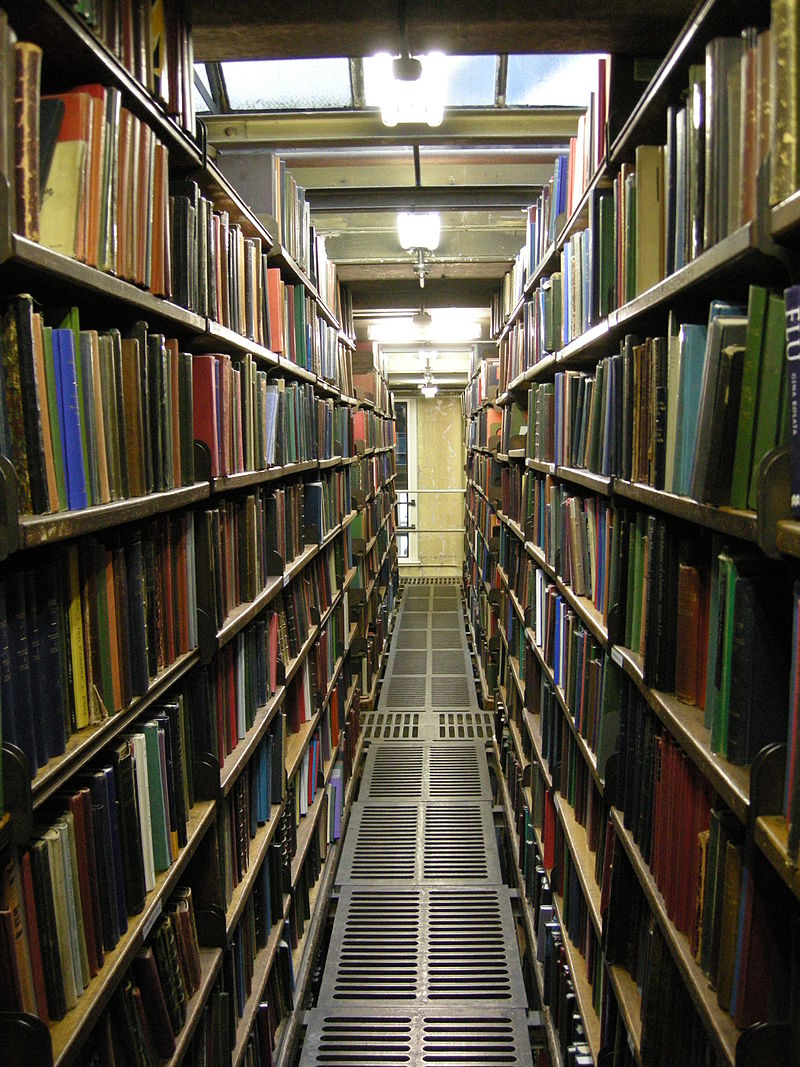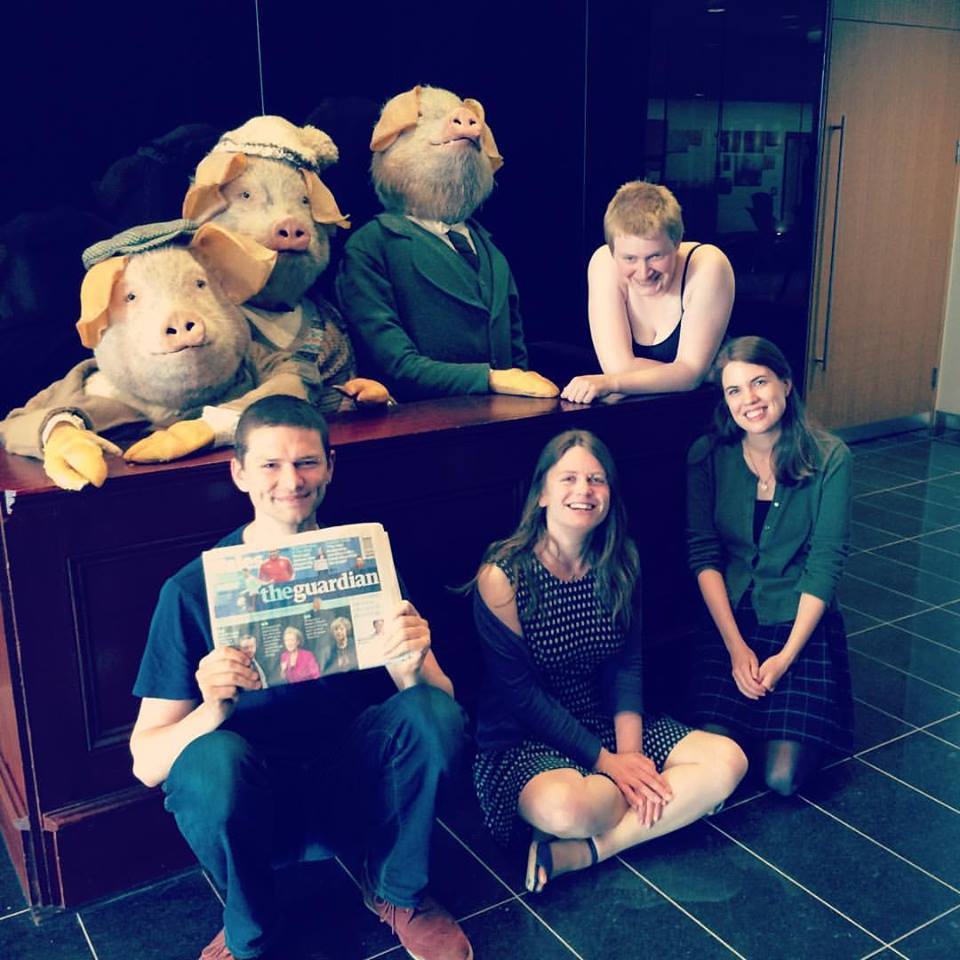The Graduate Trainees were lucky enough to visit some libraries in London at the beginning of July. We could choose two out of four different libraries, one in the morning and one in the afternoon. Here’s what we got up to.
The Natural History Museum Library – Alan McKechnie
 The Graduate Trainees meet Dippy the NHM’s famous diplodocus – photo courtesy of Danielle Czerkaszyn
The Graduate Trainees meet Dippy the NHM’s famous diplodocus – photo courtesy of Danielle Czerkaszyn
As a part of our traineeship a lucky group of us got to explore the Natural History Museum Library and Archives in London. Opened in 1881, the library and archival collections numbers over 1 million items, including books, journals, artwork, and archival items. The materials are housed across two sites (the offsite repository being based in Tring), but there is also a growing wealth of online resources available.
Our first port of call was to meet with Hellen Pethers (Reader Services Librarian) who kindly served as our tour guide. We got to view the beautiful Art-Deco style reading rooms, with dark wood panelling, exquisite metallic hand rails, and walls lined with all manner of Natural History material – it was a real treat. One of the critical talking points from Hellen was library logistics from both the standpoint of operating a split site and how they manage collections, loans, and visitors in one of the busiest museums in London. The fetch service and the pre-order of materials before a visit works exceptionally in this demanding museum. Hellen also discussed utilising the library materials for the ‘afterhours’ educational events, such as ‘Crime Scene Live’, which is a great way of giving the public access to materials and publicising the more obscure literature which might otherwise go unused.
The next talk was with Andrea Hart (Library Special Collections Manager) who had a fascinating spread of archival and special collection material for us to sample. Andrea talked in detail about the materials, which ranged from old velum covered books too warped to even be opened safely, to exquisite botanical drawings, to photographs of the founding staff of the Natural History Museum. These we viewed under the eerie and watchful marble eyes of the busts of previous naturalists and museum curators. The sheer range of materials the Natural History Museum houses was remarkable and to be given such detailed information on these materials and their preservation was a real privilege.
The final talk was given by Paul Martin Cooper (Special Collections Librarian) who discussed creating ‘The Bauer Brothers: Masters of Scientific Illustration’ exhibition currently on display. It was fascinating to learn the fine details of exhibition planning, from choosing the illustrations, to executing the quarterly rotations to keep the exhibition fresh, to how Paul chooses what to write on the display cards – the meticulous planning results in repeatedly beautiful displays. We also discussed Paul’s exhibition publication ‘Images of Nature: the Bauer Brothers’, which gives the public a take-home sample of never before published archival material.
Examining the museum’s special collection treasures – Photo courtesy of The Trustees of the Natural History Museum London
The BFI Library – Mary Atkinson
It was difficult to choose between the excellent libraries we had the opportunity to visit! However as I have an interest in film I decided that I would like to see how a specialist library like the BFI Reuben Library manages its collections and works within a large arts organisation. When I met Sarah, the Reader Services Librarian, her enthusiasm for the role of the library in promoting the study and love of film was infectious.
Located in a cultural hub between the Royal Festival Hall and the National Theatre, the BFI South Bank is the public face of the British Film Institute and hosts many screenings and events. Sarah explained that the BFI has various branches to support its aims as a major funder of film production, as well as the organisation of film festivals and events, rights clearance, fundraising and outreach work. Archives, special collections and film media are stored in their Multi Media Vault in controlled conditions. Because of this spread of activity, the South Bank location is the first point of call for enquiries from students, researchers and members of the public.
The Library is free to use and is open to everyone. I found the atmosphere warm and welcoming, with a cosy reading room, open shelf books and journals, and computers for catalogue searching and viewing digitised material. Sarah showed me some example catalogue searches to demonstrate how the library organises its complex holdings. They also hold events and talks tied in with current film screenings, and outreach activities including study sessions with A-Level Film students. The visit ended with a look at the stack where older periodicals are stored, including some brilliant early trade and fan magazines. I left feeling inspired by the range of services offered by the library, and also determined to check out the BFI’s fascinating free online resources such as the Britain on Film collection: http://www.bfi.org.uk/britain-on-film).
Danielle Czerkaszyn – The London Library
One of the stacks found at The London Library – Photo courtesy of Danielle Czerkaszyn
We arrived at 14 St James’s Square somewhat unsure of the unobtrusive entrance to the London Library. We were met by the Head of Member Services, Amanda Stubbings, who gave us a guided tour and told us more about the fascinating history of the UK’s largest independent lending library, a vast building hiding behind a deceptively modest façade…
In 1841, Scottish historian and author Thomas Carlyle decided to open a private lending library after finding that many of the policies and facilities at the British Museum Library were not to his liking. Over the years, as the collections grew, the Library attracted many of the most famous names in the literary world – Arthur Conan Doyle, Charles Darwin, Bram Stoker, Charles Dickens, George Eliot, Virginia Woolf, George Bernard Shaw, Agatha Christie, and T.S. Eliot – to name but a few. Today, the library holds over one million books and periodicals in over 50 languages, whilst also keeping pace with a growing range of electronic journals and databases.
Amanda helped us navigate the maze of different spaces in the Library; from the Victorian steel framed see-through (!) book stacks to the newest space, The Art Room, redesigned in 2014. She outlined the scope of the collections, which are particularly strong in the humanities, and highlighted some of the Library’s special collections. We were amazed by the broad range of subjects covered and given that everything is arranged by subject and author, we discovered that browsing is a dream! We also learned about future projects and refurbishment plans, including additional reading desks, three more floors of book stacks, and a new reading room.
It’s safe to say that we all left feeling highly enthused by what we’d just experienced. We loved the narrow stacks, the smell of old books and friendly nature of staff and patrons, all of whom were clearly there due to a real love of books. Membership is open to everyone for an annual fee, though the library also runs free evening tours for members of the public who fancy a quick peak. The London Library is currently celebrating its 175th birthday so there is no better time to visit this literary gem.
The Guardian – Clare Hunter
Some trainees meet the very cute stars of a Guardian advertising campaign – Photo courtesy of Tom Dale
In the afternoon four intrepid trainees took the tube to Kings Cross to explore the exciting world of news librarianship at the Guardian. We were welcomed by Richard Nelsson, the Information manager. He gave us a fascinating insight into why a newspaper might need a librarian and how the role has developed from organising cuttings in folders to searching through electronic databases. It was particularly interesting to learn about the different types of research performed by the research department and how they worked with both the Editorial staff and the archives. After our discussion we were given a quick tour of the rest of the Guardian’s offices, where we saw the hustle and bustle of the different departments of the newsroom. Finally we met with the Guardian’s archivist who took us through some of the incredible array of items in their basement store. So much of the Guardian’s history was there, from sketches for a cartoon from the 1970s to photographs of Margaret Thatcher and the smashed up parts of the hard drive that held the information released by Edward Snowden! It was fascinating to be able to learn about a very different side of librarianship that we had not seen before and see where one of Britain’s major newspapers is put together.



Recent Comments